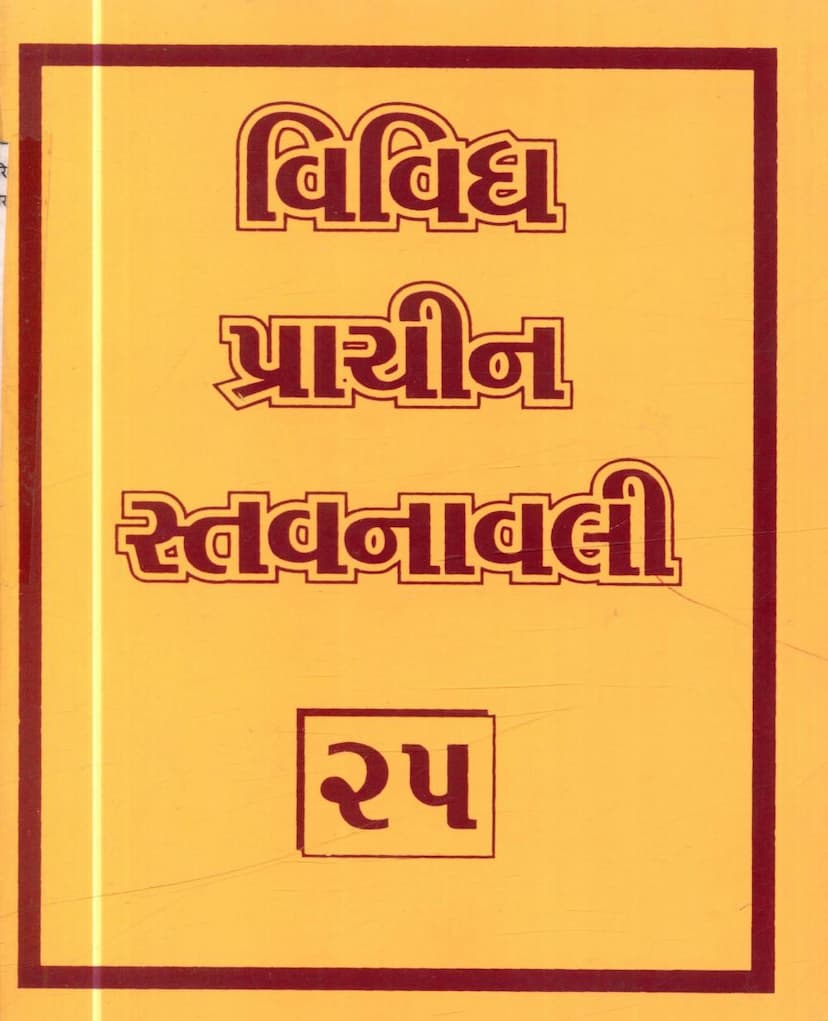Vividh Prachin Stavanavali
Added to library: September 2, 2025

Summary
Here's a comprehensive summary of the Jain text "Vividh Prachin Stavanavali" by Hasmukhbhai Chudgar:
Book Title: Vividh Prachin Stavanavali (Collection of Various Ancient Praises/Hymns) Author: Hasmukhbhai Chudgar Publisher: Hasmukhbhai Chudgar
Overall Purpose and Theme:
"Vividh Prachin Stavanavali" is a collection of devotional hymns (stanzas, or "stavans") dedicated to the Tirthankaras (Jain spiritual leaders) and important Jain concepts and rituals. The overarching theme is Paramatma Bhakti (devotion to the Supreme Soul) as a means for spiritual liberation. The book emphasizes that through sincere devotion, one can overcome worldly attachments and attain the state of the liberated soul.
Key Components and Content:
-
Introduction and Philosophy:
- The preface highlights that through devotion to the Supreme Soul, one can transcend external conditions and achieve an internal state of spiritual realization.
- It mentions that the collection includes ancient and accessible "stavans" for each Tirthankara, offering a taste of the profound devotion experienced by the composers.
- The book aims to help readers experience the joy of devotion and manifest their inner spiritual strength to move closer to liberation.
- A key message in the introductory section is that superficial devotion ("Gatanugatiktata" - doing as others do) is not enough; one must strive for genuine recognition of the Paramatma to experience true bliss and liberation. Tears shed in devotion to the Lord are far more valuable than tears shed for worldly attachments.
-
Namaskar Mahamantra:
- The collection begins with a hymn praising the Namaskar Mahamantra (Namo Arihantanam, Namo Siddhanam, etc.). It describes it as the essence of the fourteen Purvas (ancient Jain scriptures), immeasurable in its significance.
- It is recommended to chant this mantra in happiness and sorrow, day and night, alive or dying, by all beings.
- The mantra is said to contain 68 letters, signifying 68 qualities, and bestows eight types of prosperity and Siddhis (spiritual powers).
- The nine divine entities (Nav Pad) it represents offer nine types of treasures and remove the sins of countless lifetimes, ultimately leading to the Supreme Soul's state.
-
Table of Contents (Anukramanika):
- The book is systematically organized, listing various sections:
- Chaitya Vandan (Temple Worship): This section likely details the rituals and hymns associated with visiting Jain temples.
- Stavans (Hymns): This is the core of the book, containing numerous hymns dedicated to different Tirthankaras, holy places, and specific occasions.
- The table of contents provides a detailed list of the specific Tirthankaras and themes covered, indicating the vastness of the devotional content. Notable Tirthankaras mentioned include:
- Rishabhdev (Aadishwar)
- Simandhar Swami (a Vitaraga, Tirthankara of the Mahavideh Kshetra)
- Neminath
- Parshvanath
- Mahavir Swami
- Shantinath
- Mallinath
- Abhinandan
- Sumatinath
- Padmaprabha
- Pushpadanta
- Sheetalnath
- Siddhartha
- Chandraprabha
- Svasthapanaya
- Munisuvrata
- Naminath
- Vimalnath
- Anantnath
- Dharmnath
- Holy Places: Specific hymns are dedicated to prominent pilgrimage sites like Shatrunjay (Siddhachal), and mentions of other sacred locations like Met Shikhar are present.
- Occasions/Taps: Hymns related to specific observances like Gnana Panchami (Fifth day of knowledge) and Ashtami (Eighth day) are included.
- The Five Supreme Beings (Panch Parmeshthi): Hymns dedicated to Arihants, Siddhas, Acharyas, Upadhyayas, and Sadhus are present.
- The Nine Divine Entities (Nav Pad): Hymns focusing on the nine fundamental principles of Jainism.
- Twenty Virtues (Vees Sthanak): Hymns related to the 20 virtues or stages of spiritual progress.
- Vardhaman Tap: Hymns related to a specific penance.
- The book is systematically organized, listing various sections:
-
Rituals and Prayers (Chaitya Vandan Vidhi):
- The book provides detailed instructions and mantras for performing Chaitya Vandan, including:
- Ichchhami Khama Samano Sutra: A fundamental verse for seeking forgiveness and showing respect.
- Iriyavahiyam Sutra: A verse to absolve oneself of unintentional harm to living beings while moving.
- Kaussagga: Instructions on performing the act of motionless meditation, including specific "Agars" (guidelines) and verses like "Logassa."
- Javanti Cheiyai Sutra: A verse to honor all Jina images.
- Namokkurn Sutra: The core reverence verse for the Tirthankaras.
- Jay Viyaray Sutra: A prayer for victory and protection.
- Arihant Cheiyanam Sutra: A specific Kaussagga for temple worship.
- Annattha Sutra: Another Kaussagga.
- Namohasi Siddhacharyopadhyayasarvasadhubhyah: Salutations to the Panch Parmeshthi.
- The book provides detailed instructions and mantras for performing Chaitya Vandan, including:
-
Devotional Hymns (Stavans):
- The bulk of the book comprises these hymns, each with a unique melody or meter indicated (e.g., "Man Dole Tan Dole," "Pritladi Bandhani").
- These hymns express deep love, reverence, and yearning for the Tirthankaras, especially Rishabhdev and Simandhar Swami.
- Themes include:
- Praise of Holy Places: The sanctity and spiritual benefits of visiting Shatrunjay and other Tirthas are described vividly.
- Personal Devotion: Many hymns are framed as personal appeals, expressing the devotee's longing for the Lord's darshan (vision), protection, and guidance.
- Qualities of Tirthankaras: The hymns extol the unparalleled virtues, compassion, knowledge, and divinity of the Tirthankaras.
- Spiritual Journey: They often reflect on the cycles of birth and death (Bhav-bhav) and the aspiration for Moksha (liberation).
- Specific Occasions: Hymns are composed for particular days or observances, reflecting their spiritual significance.
- Metaphorical Language: Beautiful metaphors are used to describe the soul's relationship with the Divine, such as the "chakor bird and the moon" or the "lotus and the bee."
Overall Significance:
"Vividh Prachin Stavanavali" serves as a rich treasury of devotional literature for Jain practitioners. It not only provides the text for important rituals and prayers but also offers a profound collection of hymns that can deepen one's connection with the spiritual path and the Tirthankaras. The book is a testament to the enduring tradition of Jain devotional poetry and its role in spiritual practice and self-realization. It is intended for private and personal use, suggesting its role as a guide for individual spiritual reflection and worship.